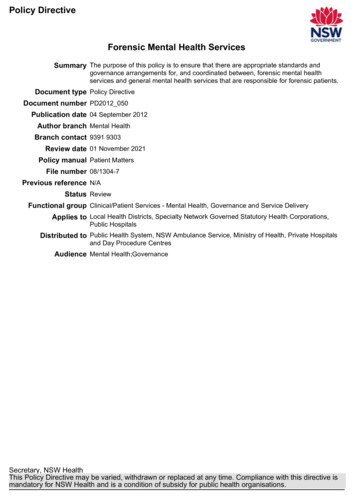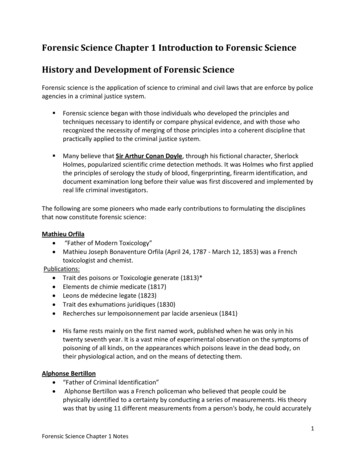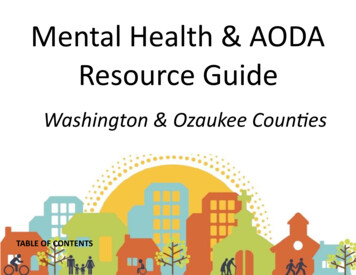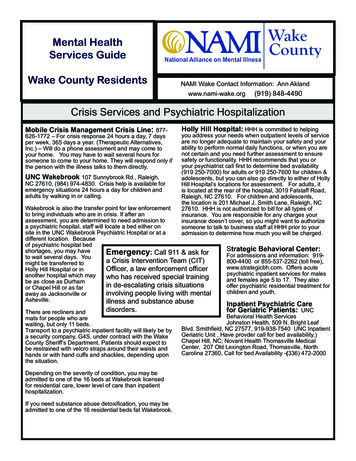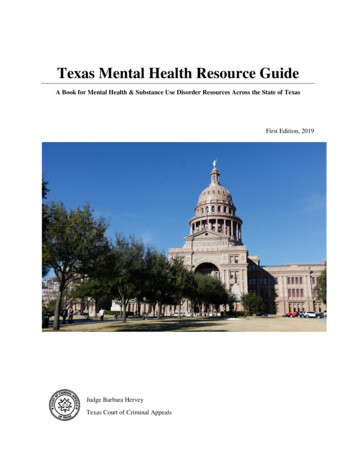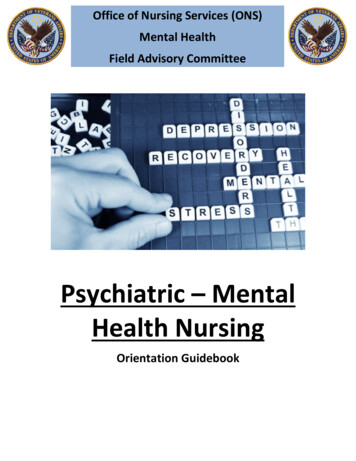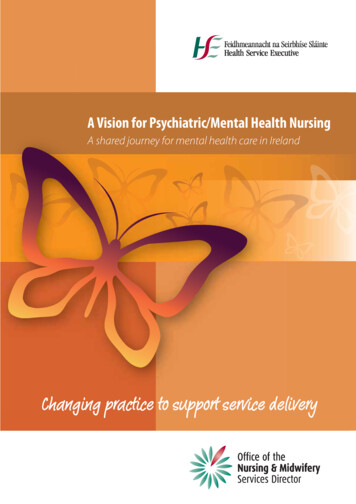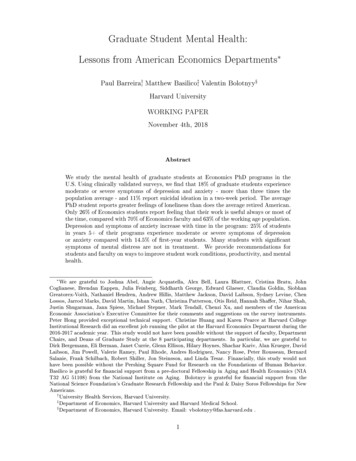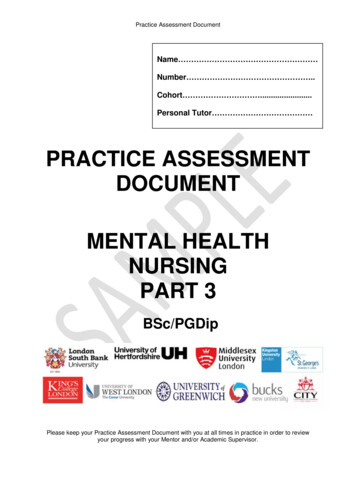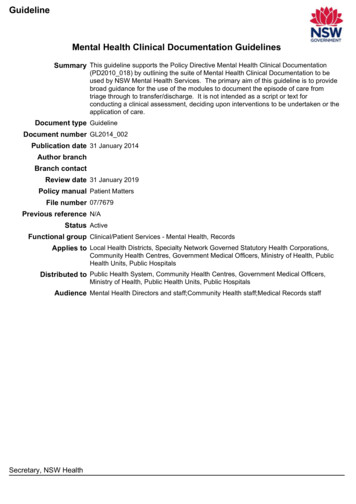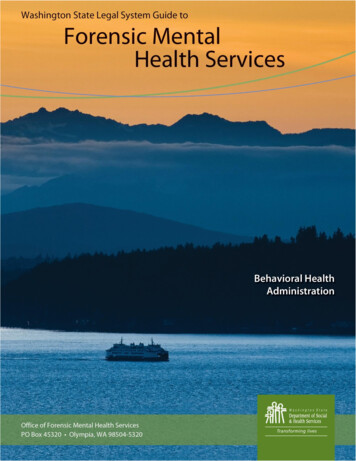
Transcription
AcknowledgmentsThe preparation of this guidebook involved the contributions of many people including the Office ofForensic Mental Health Services staff, our community partners, Amber Leaders of the State ofWashington, Office of the Attorney General, and Brian Waiblinger, M.D., Chief Medical Officer,Department of Social and Health Services. David D. Luxton, PhD., led the writing and development ofthis manual.For questions and comments regarding this guidebook, please contact:David D. Luxton, PhD., M.S.Department of Social and Health ServicesBehavioral Health AdministrationOffice of Forensic Mental Health ServicesP.O. Box 45050Olympia, WA ev. 8/2019
Table of ContentsACKNOWLEDGMENTS . . . iTABLE OF CONTENTS . . . . . . iiINTRODUCTION . . . . iii1. DEPARTMENT OF SOCIAL AND HEALTH SERVICES . . . . . . 11.1. Behavioral Health Administration . . . . 21.2. Office of Forensic Mental Health Services . . 21.3. State Hospitals . . . . . 21.4. Community Partnerships . 32. OVERVIEW OF MENTAL AND BEHAVIORAL HEALTH CONDITIONS . . 42.1. Quick Facts and Trends . . . . 42.2. Types of Mental and Behavioral Health Conditions . . 52.3. Cultural Considerations . . 103. COMPETENCY TO STAND TRIAL . . . . . . 113.1. Background . . . 113.2. Competency Evaluation and Restoration Treatment Court Orders . . . 113.3. Competency Referral Screening Assessment . . . 113.4. Competency Evaluation Process . . . . . 133.5. Sell Orders . . . . . . 134. COMPETENCY RESTORATION SERVICES . . . . . 144.1. Overview . . . 144.2. Residential Treatment Facilities Overview . . 144.2.1. Transportation . . . . 164.2.2. Medication and Personal Belongings . . . 164.2.3. Visitation at the Restoration Treatment Facilities . . . . 164.2.4. Triage Consultation and Expedited Admission . 164.3. Competency Restoration Treatment . . . 165. NOT GUILTY BY REASON OF INSANITY (NGRI) . . . . 185.1. Background . . . 185.2. Mental Health Treatment Following NGRI . . . 185.3. Public Safety Review Panel . 186. CIVIL COMITTMENT . 186.1. Background . 186.2. Felony Conversions (Felony Flips) . . . 187. DIVERSION PROGRAMS . . . . . 207.1. Law Enforcement and Emergency Services . . . . 217.2. Jail and Courts . . . . . . . . 217.3. Who to Contact About Diversion Programs . . 218. ADDITIONAL RESOURCES . 229. GLOSSARY . . . 2310. REFERENCES . . . . 24ii
Washington State Legal System Guide toForensic Mental Health ServicesBehavioral Health AdministrationOffice of Forensic Mental Health ServicesINTRODUCTIONEach day in our state and in the nation, many people with mental illness come into contact with thecriminal justice system. It is important for courts, attorneys, law enforcement, correctional facilities,administrators and other community partners to understand what services are available to divert,evaluate or treat individuals in the criminal justice system with psychiatric illness. Navigating theseservices and the processes that are required can seem daunting. The goal of this guidebook is to provideneed-to-know information and practical direction to interested parties about forensic mental healthservices for adults in Washington. This guidebook is for informational purposes only and it is notintended for legal or clinical decision making nor is it a legally binding policy document.This guidebook will cover the following areas: an overview of the forensic mental health system;background on mental and behavioral health conditions germane to the forensic mental health system;a need-to-know overview of competency evaluation and restoration processes; the civil commitmentprocess including when a defendant’s charges are dismissed and a civil commitment is pursued; andfinally, an overview of diversion options. This guidebook does not cover specific behavioral healthservices for violent sex offenders, juveniles, or services in correctional settings. A list of additionalresources and contact information is provided.We appreciate your partnership and assistance to improve services to clients served by our forensicmental health system. We look forward to working with you.Behavioral Health Administration-iiiOffice of Forensic Mental Health Services
1. DEPARTMENT OF SOCIAL AND HEALTH SERVICESThe Department of Social and Health Services (DSHS) is Washington's largest state agency. In any givenmonth, DSHS provides some type of shelter, care, protection and/or support to 2.4 million of our state's7.1 million people.Our goal and commitment is to be a national leader in every aspect of client service. Our agency’s fivepriorities consist of preparing for aging Washingtonians; supporting people in our care and custody;serving people in their home community; and increasing organizational efficiency, performance andeffectiveness.Economic Services AdministrationDepartment of Social and Health ServicesDavid Stillman, Assistant Secretary Child Support Community Services Disability Determination Services Program IntegrityCheryl Strange, SecretaryOffice of the SecretaryDon Clintsman, Chief of StaffDana Phelps, Deputy Chief of Staff Audits Communications Diversity and Inclusion Enterprise Risk Management Enterprise Technology Human Resources Indian Policy Information and Governance Innovation and Strategy Legislation and Constituent Relations Policy and Rules Technology ServicesFacilities, Finance and Analytics Administration Aging and Long-term Support AdministrationBill Moss, Assistant Secretary Adult Protective Services Home and Community Services Residential Care ServicesJudy Fitzgerald, Chief Financial Officer Administrative Services Capital Programs Central BudgetContracts, Legal and Background Check Services Consolidated Maintenance Emergency Management Financial Recovery Finance Services Fraud and Accountability Leased Facilities and Warehouse Management Services Research and Data AnalysisDivision of Vocational RehabilitationRobert Hines, Senior Director Assessment Services Assistive Technology Services Independent Living Services Job-related ServicesBehavioral Health AdministrationSean Murphy, Assistant Secretary Child Study and Treatment Center Eastern State Hospital Forensic Mental Health Services Special Commitment Center Western State HospitalDevelopmental Disabilities AdministrationEvelyn Perez, Assistant Secretary Community Residential Services Fircrest School Lakeland Village Rainier School Yakima Valley School1
1.1 Behavioral Health AdministrationBehavioral Health Administration (BHA) transforms lives by supporting sustainable recovery,independence and wellness. We do this through funding and supporting effective prevention andintervention services for youth and families, and treatment and recovery support for youth and adultswith addiction and mental health conditions (also known as behavioral health). It operates three statepsychiatric hospitals: Eastern State Hospital (ESH), located in Medical Lake; Western State Hospital(WSH) and the Child Study and Treatment Center (CSTC), located in Lakewood; the Special CommitmentCenter (SCC) located on McNeil Island; and oversees the Office of Forensic Mental Health Services(OFMHS). In addition to the state hospitals, two Residential Treatment Facilities in Yakima and Centraliadeliver high-quality competency restoration services and the Northern Regional Office in Seattle, as wellas outstations located in several counties provide forensic evaluation services.1.2 Office of Forensic Mental Health ServicesThe DSHS’s Office of Forensic Mental Health Services (OFMHS) with headquarters in Lacey is responsiblefor the leadership and management of the Department’s adult forensic mental health care system. TheOFMHS provides forensic evaluations, competency restoration, Not Guilty by Reason of Insanity (NGRI)treatment services, and liaison services to effectively coordinate efforts with system partners to meetshared goals.The OFMHS additionally provides ongoing training and technical assistance to improve quality andtimeliness of forensic mental health services, data management and resource allocation, training andcertification of evaluators, and quality monitoring and reporting.The OFMHS works in collaboration with community partners implement robust diversion efforts toprevent individuals with mental illness from entering the criminal justice system.1.3 State Hospitals1.3.1 Eastern State Hospital (ESH) is a 287-bed inpatient psychiatric hospital which is accredited bythe Joint Commission and certified by the Centers for Medicare and Medicaid Services (CMS). ESH islocated in the city of Medical Lake, approximately 20 miles west of Spokane. ESH is one of two stateowned psychiatric hospitals for adults in the state of Washington and it provides services to individualsin 20 eastern Washington counties. ESH provides evaluation and inpatient treatment for individuals withserious or long-term mental illness that have been referred to the hospital through the BehavioralHealth Organizations (BHOs)/Managed Care Organizations (MCOs) when individuals have receiveda civil court order for involuntary treatment (see RCW 71.05) or through the criminal justice systemwhen individuals have received a forensic court order for involuntary treatment- (see RCW 10.77).The Forensic Services Unit (FSU) - FSU is a 95 bed inpatient unit for patients who enter the forensic(legal) unit at ESH through the criminal justice system. Evaluation and treatment services are providedfor adults prior to their trial, after they are convicted, or after they are acquitted by reason of insanity.1.3.2 Western State Hospital (WSH) is located in the city of Lakewood and is one of the largestpsychiatric hospitals west of the Mississippi with more than 800 beds and 2700 employees. WSHprovides evaluation and inpatient treatment services for individuals with serious or long-term mentalillness in 20 western Washington counties. Patients are referred to the hospital through a BehavioralHealth Organization (BHO)/Managed Care Organization (MCO) when individuals meet the criteria for2
involuntary treatment through the civil system (see RCW 71.05) or through the criminal justice system(see RCW 10.77).The Center for Forensic Services (CFS) is located on the WSH campus and serves clients who have beencommitted to the hospital under criminal proceedings (RCW 10.77). These clients include defendantsundergoing inpatient evaluation for competency to stand trial and/or mental state at the time of thecriminal offense, as well as clients who have been found Not Guilty by Reason of Insanity (NGRI). TheCFS contains five treatment units which primarily house patients that are undergoing forensicevaluation/competency restoration and six treatment units which house NGRI patients. There arepresently 330 beds allocated to forensic patients.In 2016, DSHS established through a collaboration between Correct Care Recovery Solutions two newResidential Treatment Facilities (RTF) to provide inpatient competency restoration services for adults.The Maple Lane Competency Restoration Program is a 30 bed facility operated out of the CascadeCottage on the former Maple Lane School campus in Centralia. The Yakima Competency RestorationCenter is a 24 bed facility in Yakima. These RTF’s are described in more detail in Section 4.2 of theguidebook.1.3.3 The Child Study and Treatment Center (CSTC), located in Lakewood, WA, is the only stateoperated and funded psychiatric hospital for children and youth (ages 5 to 18) (Washington StateDepartment of Social and Health Services, 2016). Accredited by The Joint Commission, CSTC is a securecampus designed for youth who cannot be served safely in less restrictive community settings. Theaverage length of stay is approximately six months to one year. CSTC has a total capacity of 47 bedsdivided among three age- and developmentally-based cottages. Camano Cottage serves children ages 6to 12, Ketron Cottage serves youth up to age 14, and Orcas Cottage serves the older youth up to their18th birthday. Elementary, middle and high school educational services are provided by the Clover ParkSchool District (CPSD) under an agreement authorized by RCW 28A.190.040. CPSD coordinateseducational planning with home school districts prior to admission and upon discharge.Psychiatric treatment at the CSTC incorporates the most current evidence-based practices includingcognitive behavioral therapy (CBT), trauma-focused CBT, Dialectical Behavior Therapy (DBT), skillsdevelopment, family and recreational therapies. Clinical services include medication management and24-hour nursing services. The CSTC works with families, guardians and community supports in treatmentand discharge planning so that children can successfully transition back to their family home, orcommunity-based foster placement. The CSTC is committed to culturally competent care for childrenwith severe emotional disorders whose needs are often complicated by developmental, medical, social,and legal issues (Washington State Department of Social and Health Services, 2016).1.4 Community PartnershipsPatients whose medical needs require additional care beyond the hospitals are served in local medicalhospitals and clinics. The hospitals works closely with the local courts and the Criminal Justice System toprovide forensic evaluations throughout the state. Staff also work with Behavioral Health and ManagedCare Organizations in every county to ensure that patients receive adequate outpatient treatments andhousing upon their discharge from a state hospital. As of 2019, these services are purchased byregionally operated BHOs through a managed-care structure.3
2. OVERVIEW OF MENTAL AND BEHAVIORAL HEALTH CONDITIONS2.1 Quick Facts and TrendsAccording to data from SAMSHA (Blandford & Osher, 2013), the rate of any mental illness among adultsis higher in the state of Washington compared to the National average (See Figure 1.).Figure 1. Rate of any mental illness among adults.The rate of serious mental illness among adults is also higher in Washington compared to the nationalaverage (SAMHSA, 2013) (See Figure 2.).Figure 2. Rate of serious mental illness among adults.In forensic populations, the prevalence of mental illness is even higher. The estimated proportion ofadults with mental health, Substance Use, and Co-occurring Disorders in U.S. Population and underCorrectional Control and Supervision are shown below in Table 1.Table 1. Estimated proportion of adults with mental health, Substance Use, and Co-occurring Disordersin U.S. Population and under Correctional Control and nand ParoleSerious Mental Disorders5.4%16%17%7-9%Substance Use %21%Co-occurring Substance Use Disorderw/Serious Mental DisorderCo-occurring Serious Mental Disorderw/Substance Use DisorderSource: Blandford and Osher (2013).4
There are 10 times more individuals with serious mental illness in jails and state prisons than there arein state mental hospitals (Torrey, Zdanowicz, Kennard et al. 2014). Nationally, only one-in-three stateprisoners and one-in-six jail inmates report having received mental health treatment since theiradmission (James and Glaze 2006).Female inmates have higher rates of mental health problems than male inmates (state prisons: 73% offemales and 55% of males; local jails: 75% of females and 63% of males) (James & Glaze, 2006). Also, Jailinmates who had a mental health problem (24%) were three times as likely as jail inmates without (8%)to report being physically or sexually abused in the past (James & Glaze, 2006).Individuals with mental illness are also at higher risk of re-entering the criminal justice system (Barr,1999). Approximately 49% percent of federal prisoners with mental illness have three or more priorprobations, incarcerations or arrests, compared to 28% without mental illness (Ditton, 1999). Familymembers report that the average number of arrests for their relative with mental illness is more thanthree (McFarland, Faulkner, Bloom & Hallaux, 1989).2.2 Types of Mental and Behavioral Health ConditionsAny type of mental or behavioral health disorder found in the general population is found amongdefendants in the criminal justice system. This section of the manual presents some of the mostcommon conditions, especially those that require consideration when determining the need forcompetency evaluation.The assessment and diagnosis of clinical conditions are conducted by licensed health care providers. TheDiagnostic and Statistical Manual of Mental Disorders, Fifth Edition (DSM-5), published by the AmericanPsychiatric Association (2013), is the handbook used by health care professionals to classify anddiagnose mental health disorders. Mental illness is different than cognitive impairment ordevelopmental disability, although they may both be present. The information presented here isintended to provide a general overview and should not be used for legal or clinical decision making.Psychotic DisordersPsychotic disorders are severe mental disorders that can result in abnormal thinking, delusions, andperceptual distortions. People with psychoses can be said to experience an altered reality. Two of themain symptoms are delusions and hallucinations:Delusions are false or erroneous beliefs that usually involve a misinterpretation of perceptions orexperiences. A person experiencing delusions may experience: Beliefs that someone is plotting against them (persecutory delusions). Beliefs that external forces are controlling their thoughts, feelings and behavior. Beliefs that trivial remarks, events, objects, or other environmental cues have personalmeaning or significance, thinking that the TV is sending them secret messages. (ideas or delusions of reference). Thinking that they have special powers, are on a special mission, or that they are God.5
Hallucinations are false perceptions that may occur in any sensory modality (e.g., auditory,olfactory, gustatory, visual, and tactile). For example, a person experiencing hallucinations mayexperience: Voices conducting a running commentary on the person’s thoughts or behavior. Voices telling the person to commit acts of violence or self-harm. Feeling like something is crawling on or under their skin. Seeing someone take the shape of something, such as a demon.In DSM-5, primary psychotic disorders are broadly classified under Schizophrenia Spectrum and OtherPsychotic Disorders (45). Schizophrenia is one type of psychotic disorder. Lack of insight into one'smental illness is very common among individuals with Schizophrenia and may include a completedisbelief that they have a disorder. This can create barriers to engaging in treatment and to medicationand treatment adherence. Ensuring engagement with treatment often requires external motivators(e.g. housing, financial and emotional support). Examples of other disorders with psychotic features areSchizoaffective Disorder, Delusional Disorder, Schizophreniform Disorder, and Brief Psychotic Disorder.People with Bipolar Disorder and depression (and transiently in personality disorders) may also presentwith psychotic symptoms. These can be differentiated from primary psychotic disorders due to theirabsence of psychosis in the absence of mood symptoms. The use of alcohol and some substances (e.g.,marijuana, LSD, amphetamines and other substances) can precipitate psychosis in people who arealready vulnerable. Other problems that can cause psychosis include metabolic abnormalities/delirium,dementia, brain tumors, brain infections, and stroke.Treatment depends on the cause of the psychosis. Medications such as anti-psychotics, antidepressantsand mood stabilizers help to control symptoms and individual or group therapy may be recommended.Hospitalization may also be appropriate for serious cases where a person might be dangerous to self orothers or gravely disabled.Depressive DisordersDepressive disorders are characterized by sadness severe enough or persistent enough to impair social,occupational or other important areas of functioning. The term depression is often used to refer to anyof several depressive disorders. The DSM-5 defines depressive disorders by specific types: Major depressive disorder (often called major depression and may be single or recurrentepisodes)Persistent depressive disorder (also called dysthymia)Other specified or unspecified depressive disorderPremenstrual Dysphoric DisorderSubstance/Medication-Induced Depressive DisorderDepressive Disorder Due to Another Medical ConditionDisruptive Mood Dysregulation disorder (in children age 6-18).6
Depressive symptoms or disorders may also accompany physical disorders, including Vitamin and B12deficiency, thyroid/parathyroid and adrenal gland disorders, stroke, traumatic brain injury, seizures,Infections (HIV/AIDS, syphilis, hepatitis C, CJ and Lyme disease, West Nile virus), Parkinson disease,multiple sclerosis and malignancies (paraneoplastic syndromes and pancreatic cancer). Certainmedications, such as anti-epileptics, beta-blockers, corticosteroids, Interferon, Accutane, Chantix, Zyban,and reserpine, can also result in depressive disorders.Treatment may include medications and/or individual or group therapy. Psychiatric hospitalization issometimes necessary.NOTE: Mood disorders are less frequent than psychotic disorders in criminal forensic evaluations, butmay be relevant in competence-to-stand-trial and insanity evaluations. They are more common in civilforensic evaluations, particularly disability evaluations (Parker, 2014).Bipolar and Related DisordersThe two main types of bipolar disorders are bipolar I and bipolar II according to the DSM-5. Bipolar Idisorder involves episodes of severe mania and often depression. Bipolar II disorder involves a lesssevere form of mania called hypomania. Mania is defined by a distinct period of abnormally andpersistently elevated, expansive, or irritable mood lasting at least a week that is sufficiently severe tocause marked impairment in social/occupational functioning or in usual activities or relationships withothers or to require hospitalization to prevent harm to self, others, or there are psychotic features.An individual experiencing a manic episode may experience elevated self-esteem, have little need forsleep, have increased rate of speech (talking fast), experience flight of ideas or be easily distracted.They also typically have increased energy and interest in goals or activities though they may havedifficulty finishing them. They may also engage in risky or reckless behavior, such as risky sexualbehavior, spending excessive amounts of money, or making impulsive decisions. During a hypomanicepisode, a person may experience similar symptoms but they do not experience psychotic symptoms, itis still noticeable to others but does not cause major functional impairment. Many individuals whoexperience hypomania associated with bipolar II experience the feeling of increased energy anddecreased need for sleep, but typically do not require hospitalization.Treatment of bipolar I disorder is highly individualized and based on the types and severity of symptomsa person may be experiencing. Mood stabilizers and atypical antipsychotics are typically the coretreatment. Behavioral and Cognitive Behavioral Therapy (CBT) may also be helpful.Anxiety DisordersAnxiety disorders are characterized by feelings of anxiety and fear that are severe and persistent enoughto interfere with daily activities and functioning. Examples of anxiety disorders include generalizedanxiety disorder, obsessive-compulsive disorder, post-traumatic stress disorder (PTSD), panic disorder,and social anxiety disorder. Any of these conditions may co-occur with other mental health conditionsand substance use disorder. Persons with PTSD, for example, may also experience dissociativesymptoms (i.e., flashbacks and intrusive thoughts), that must be differentiated from perceptualdisturbances that occur in psychotic disorders.7
Treatments for anxiety disorders may include psychotherapy, such as Cognitive Behavioral Therapy(CBT), Eye Movement Desensitization and Reprocessing (EMDR) and medications includingantidepressants and anti-anxiety agents.Personality DisordersPersonality disorders are associated with enduring patterns of inner experience and behavior thatmarkedly deviates from ones culture and causes difficulties with perception, interpersonal interactions,emotional regulation, and impulsivity. These patterns develop early, are inflexible, and are associatedwith significant distress or disability (APA, 2013).Personality disorders fall within 10 distinct types: paranoid personality disorder, schizoid personalitydisorder, schizotypal personality disorder, antisocial personality disorder, borderline personalitydisorder, histrionic personality, narcissistic personality disorder, avoidant personality disorder,dependent personality disorder and obsessive-compulsive personality disorder (APA, 2013). Personalitydisorders may co-occur with other conditions and can influence competency of criminal defendants.Examples of psychotherapy treatments for some personality disorders include Dialectical BehavioralTherapy (DBT) and Cognitive Therapy (CT). Psychiatric medications may help with various symptomsand co-occurring disorders associated with personality disorders.Neurocognitive DisordersNeurocognitive disorder refers to impaired mental function from a medical condition other than aprimary psychiatric disorder. Impaired brain function may be caused by: Trauma (bruising of the brain or bleeding into the brain or space around the brain),Lack of oxygen (hypoxia, hypercapnia)Cardiovascular disorders (e.g., stroke, atherosclerosis)Degenerative disorders (e.g., Parkinson’s Disease, dementia caused by metabolic disorders)Delirium (electrolyte abnormalities, Infections (e.g., Meningitis), substance use, vitamindeficiency, etc.)NOTE: Other conditions, such as Depression, Psychosis, etc. can mimic Neurocognitive Disorders.Substance Use DisordersSubstance use disorders occur when the recurrent use of alcohol and/or substances causes clinically orfunctionally significant distress and often causes impairment, such as health problems, disability, andfailure to meet major responsibilities at work, school, or home. According to the DSM-5, a diagnosis ofsubstance use disorder is based on evidence of increased impaired control, social impairment, risky use,and pharmacological criteria. Substance use disorders are defined as mild, moderate, or severe toindicate the level of severity, which is determined by the number of diagnostic criteria met by anindividual.Substance use disorder in DSM-5 combines the previous DSM-IV categories of substance abuse andsubstance dependence into a single disorder measured on a continuum from mild to severe. Eachspecific substance (other than caffeine, which cannot be diagnosed as a substance use disorder) is8
addressed as a separate use disorder (e.g., alcohol use disorder, stimulant use disorder, etc.), but nearlyall substances are diagnosed based on the same overarching criteria.Co-occurring DisordersA diagnosis of co-occurring mental illness and substance uses disorder or “co-occurring disorder”(previously referred to as “dual diagnosis”) describes the presence of both a mental disorder and asubstance use disorder. National research suggests that as many as three out of every four criminaldefendants in major cities test positive for illegal substances at the time of arrest (National Institute ofJustice, 1998). People with substance use disorders are more likely to develop mental illness and peoplewith mental illness are more likely to develop a substance use disorder (Peters & Hills, 1997; Massaro &Pepper, 1994).People with co-occurring disorders are at higher risk for homelessness, human immunodeficiency virus(HIV), Hepatitis C, violent behavior, trauma (e.g., Post-Traumatic Stress Disorder), unemployment, andsocial and family relationships problems (Peters & Hills, 1997; Broner, et al., 2000). The presence of cooccurring conditions may complicate the assessment and restoration of competency to stand trial.Factitious DisordersA person with a factitious disorder intentionally (consciously) produces, feigns or exaggerates thesymptoms of a disease, illness or psychological condition with the aim of assuming the patient role. Themotive varies but may include a desire to seek comfort and attention, attempt to gain access tomedications, or a fascination with the medical field.The DSM-5 criteria for factitious dis
Washington State Legal System Guide to Forensic Mental Health Services Behavioral Health Administration Office of Forensic Mental Health Services INTRODUCTION Each day in our state and in the n
